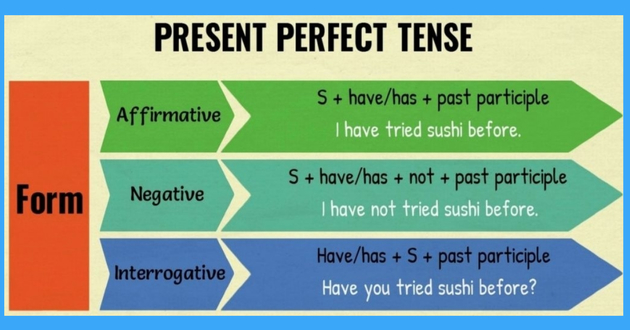Present Perfect – Presente perfeito em Inglês
O present perfect é um tempo verbal que expressa ações influenciadas pelo presente. usamos para ações que ainda estão acontecendo ou foram concluídas recentemente, ele pode ser usado para indicar ações que começaram no passado e se prolongam até o presente.
EXEMPLOS:
They have studied a lot for the exams.
Eles têm estudado muito para os exames
I have been living in Rio de Janeiro since 2010.
Estou estou morando no Rio de Janeiro desde 2010.
I’ve just seen him on the corner.
Eu acabei de vê-lo na esquina.
I’ve just lost five bucks.
Acabei de perder seis reais.
O present perfect pode ser utilizado em diversas situações, então aqui vai um esqueminha para que você entenda quando utilizá-lo:
AÇÕES INICIADAS NO PASSADO E EM ANDAMENTO NO PRESENTE
They haven’t lived here for years.
Eles não moram aqui por anos.
She has worked in the bank for five years.
Ela trabalha no banco por 5 anos.
We have had the same car for ten years.
Nós temos o mesmo carro por 10 anos
QUANDO SE FAZ REFERÊNCIA A UM PERÍODO DE TEMPO INCONCLUÍDO
I have worked hard this week.
Eu trabalhei muito esta semana.
It has rained a lot this year.
Choveu muito este ano.
We haven’t seen her today.
Não a vimos hoje.
AÇÕES REPETIDAS EM UM PERÍODO NÃO ESPECÍFICO ENTRE O PASSADO E O PRESENTE
They have seen that film six times.
Eles viram aquele filme seis vezes.
It has happened several times already.
Já aconteceu várias vezes.
She has visited them frequently.
Ela os visita com frequência.
AÇÕES CONCLUÍDAS NO PASSADO MUITO RECENTE (+just)
Have you just finished work?
Você acabou de trabalhar?
I have just eaten.
Acabei de comer.
We have just seen her.
Acabamos de vê-la.
QUANDO O PERÍODO EXATO DA AÇÃO É IRRELEVANTE OU DESCONHECIDO
Someone has eaten my soup!
Alguém comeu minha sopa!
Have you seen ‘Gone with the Wind’?
Você já viu ‘E o Vento Levou’?
She’s studied Japanese, Russian, and English.
Ela estudou japonês, russo e inglês.
Como montar frases com o present perfect:
ESTRUTURA AFIRMATIVA:
SUJEITO+HAVE +VERBO P. PARTICÍPIO+ COMPLEMENTO
John and Sarah have lived at the same place since I met them.
John e Sarah moram no mesmo lugar desde que eu os conheci.
I have just finished my work.
Acabei de terminar meu trabalho
PARA HE/SHE/IT
SUJEITO+HAS +VERBO P. PARTICÍPIO+ COMPLEMENTO
Sarah has lived at the same place since I met her.
Sarah mora no mesmo lugar desde que eu a conheci.
He has just finished hiswork.
Ele acabou de terminar o trabalho dele.

ESTRUTURA NEGATIVA:
SUJEITO+HAVE NOT(HAVEN’T) +VERBO P. PARTICÍPIO+ COMPLEMENTO
John and Sarah haven’t lived at the same place since I met them.
John e Sarah não moram no mesmo lugar desde que eu os conheci
I haven’t finished my work.
Eu não terminei meu trabalho
PARA HE/SHE/IT
SUJEITO+HAS NOT (HASN”T) +VERBO P. PARTICÍPIO+ COMPLEMENTO
Sarah hasn’t lived at the same place since I met her.
Sarah não mora no mesmo lugar desde que eu a conheci.
He hasn’t finished his work.
Ele não terminou o trabalho dele.
ESTRUTURA INTERROGATIVA:
HAVE +SUJEITO+VERBO P. PARTICÍPIO+ COMPLEMENTO
Have John and Sarah lived at the same place since I met them?
John e Sarah moram no mesmo lugar desde que eu os conheci?
Have you finished your work?
Você terminou seu trabalho?
PARA HE/SHE/IT
HAS +SUJEITO+VERBO P. PARTICÍPIO+ COMPLEMENTO
Has Sarah lived at the same place since I met her?
Sarah mora no mesmo lugar desde que eu a conheci?
Has he finished his work?
Ele terminou o trabalho dele?
CONTRAÇÃO DO HAVE
GERALMENTE O VERBO TO HAVE NO PRESENT PERFECT, QUE É USADO COMO
AUXILIAR DO VERBO PRINCIPAL, É CONTRAÍDO E SE TRANSFORMA EM (‘VE)
Na 3ª pessoa do singular (he/she/it), que tem conjugação “has”, a abreviação é ” ‘s”.
Exemplos:
No, I’ve never been there.
Não, eu nunca estive lá.
He’s already been there.
Ele já esteve lá.
Você também vai gostar:




Seja o primeiro a comentar!